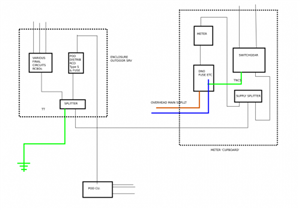I am trying to get my head around surge protection - the *basic type and positioning* really- and taking an example situation please where surge protection may be added:
A moorland, overhead supplied, residential property; TN-C-S.
Outdoor regular wall meter cupboard in which is the DNO head, meter and some existing consumer switchgear (been as it is for over a decade with RCDs, MCBs from when the supply was TT) in an enclosure fed via a supply splitter block [henly] , which is there to supply two consumer units each at either end of the property.
Also fed from the splitter block, a supply to another nearby enclosure in which resides switch gear for TT outdoor services - lamp columns and electric gate 30ma RCBO final circuits and a RCD type s distrib circuit to a 'garden work pod' which has a little sub-board.
(rough block diag attached to help description)
1) What would be the positioning and type of any surge protection (where there is no LPS on the building rightly or wrongly) ?
my questioning thoughts on this:
- near the origin (as in the source of energy) a Type 1 as it is overhead fed, but not sure if CT1 or CT2 connection
- in the consumer units a type 2 CT1 connected
- for the TT outdoor final circuits a type 2 , does this have to be upfront of RCBO being TT and CT1 or CT2
- for the TT pod distrib circuit, a type 2 and none in the 'pod' sub board, or none and type 2 in the pod subboard
- does the outdoor TT install even require SPD; can a 'surge' propogate back uptream into other parts
- future considerations, if alterations made e.g.
2) Lastly, is SPD simply about protecting connected equipment, or is it also about protecting conductor insulation from voltages that might damage it ?
It does seem that adding type 1 SPD at the 'origin' (in meter box - other one is possible) into this situation is nigh impossible without major works, so unless its possible to simply add it to each consumer unit/subboard as such... it seems academic, but still it would be interesting to know where it should go ideally.
Regards
Habs
(perhaps one's ambition outweighs one's abilities)

(last para edited for clarity ... well that was the intention)